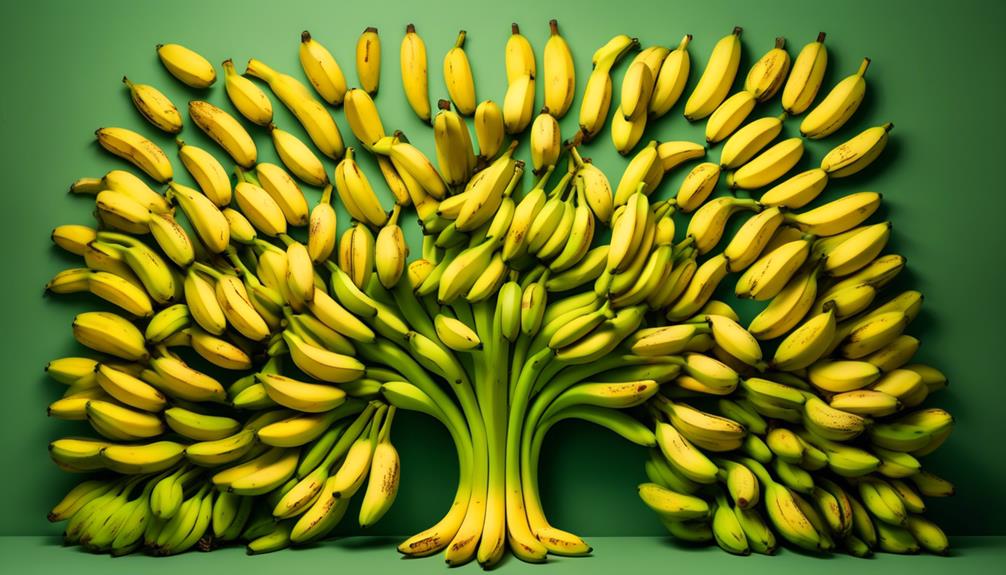Peel back the layers of language with our intriguing exploration of the collective noun for bananas.
Collective Noun for Bananas
Like a bunch of bananas hanging from a tropical tree, collective nouns add a unique flavor to our language. You’ve probably used them more times than you can count, but have you ever stopped to think about their origin or why we use them?
For instance, why do we say a ‘bunch of bananas’ and not a ‘group of bananas’? The answer might surprise you. Unraveling the mystery of collective nouns, particularly for bananas, can offer fascinating insights into the English language and its evolution.
Who knows, you might just discover something that’ll change the way you look at your fruit bowl.
Key Takeaways
- Collective nouns represent a group of people, animals, or things and are singular in form but plural in meaning.
- The collective noun for bananas is ‘hand’, which comes from the way bananas grow in clusters resembling a hand.
- The term ‘bunch’ is used to describe the larger cluster formed by the grouping of ‘hands’.
- Collective nouns for fruits, such as ‘crop’ or ‘orchard’ for apples, ‘stand’ or ‘grove’ for oranges, ‘bunch’ or ‘cluster’ for grapes, and ‘knot’ or ‘bramble’ for berries, reflect their unique growth patterns.
Understanding Collective Nouns

Before diving into the specific collective noun for bananas, let’s first get a strong grip on what collective nouns are and how they function in our language. You see, collective nouns are words that represent a group of people, animals, or things. They’re unique in that they’re singular in form but plural in meaning. Think of words like ‘team’, ‘flock’, ‘herd’ – all these are examples of collective nouns.
Now, let’s get a bit more analytical. In English, collective nouns can take either singular or plural verbs depending on whether you’re thinking of the group as a single entity or as individual members. For instance, you’d say ‘The team is winning’ if you’re considering the team as a whole. But if you’re thinking of them as individuals doing their own thing, you’d say ‘The team are arguing among themselves’.
You can see how collective nouns add a level of precision and detail to our language, allowing us to express complex ideas with simplicity.
Origin of Banana’s Collective Noun

Delving into the origin of the collective noun for bananas, you’ll find that it’s as intriguing as the fruit itself. It’s not a random choice of words, but a term steeped in history and rich in symbolism.
The phrase ‘hand of bananas’ owes its origins to the way bananas naturally grow. When you look at a banana plant, you’ll notice that bananas grow in clusters attached to the plant’s stalk. These clusters resemble a hand, each banana akin to a finger, prompting people to refer to the cluster as a ‘hand’. This analogy is so precise, it’s used worldwide.
Similarly, the term ‘bunch of bananas’ comes from the fact that these ‘hands’ group together on the stalk, forming a larger cluster that resembles a bunch.
These terms aren’t merely descriptive; they’re a testament to our ancestors’ knack for observation and linguistic creativity. By using them, you’re not just referring to a group of bananas, but also acknowledging the fruit’s unique growth pattern.
Other Fruits’ Collective Nouns

Just as bananas have their unique collective nouns, other fruits also possess interesting terms that reflect their nature, growth patterns, or historical usage.
For example, you’d refer to a group of apples as a ‘crop’ or ‘orchard,‘ which illustrates their typical growth in vast, meticulously arranged tree farms.
Oranges, on the other hand, are described as a ‘stand’ or ‘grove,’ signifying their cultivation in smaller, less organized spaces.
Grapes, due to their clustered growth, are known as a ‘bunch’ or ‘cluster.’
Now, let’s consider berries. They’re known collectively as a ‘knot’ or ‘bramble,’ terms that reflect their tangled, thicket-like growth patterns.
You’d use ‘hand’ or ‘bunch’ for bananas, given their distinct, hand-like grouping on trees.
These collective nouns don’t just randomly appear; they’re born out of careful observation of each fruit’s growth, nature, and history.
The terms enhance our language, making it more descriptive and precise.
Usage in Everyday Language

While you may not realize it, these collective nouns for fruits have subtly woven themselves into our everyday language, thus enriching our conversations and expressions. Take the term ‘hand’ for bananas, for example. It’s not just a jargon used by banana growers or grocers, but it’s also commonly used by us in our grocery lists, meal plans or dietary advice.
This use of collective nouns extends beyond practicalities. It contributes to the colorful tapestry of our language, adding depth and nuance to our expressions. For instance, you might hear someone describe a situation as ‘going bananas’, playing on the collective noun to convey a sense of chaos or craziness.
So, it’s not just about the precision that these terms bring to our language. They also imbue our conversations with a certain charm and richness. That’s the beauty of language. It’s not static. It’s ever-evolving, absorbing words and expressions from wide-ranging sources, including the collective nouns for fruits.
As you navigate through your day, try to spot these instances where collective nouns creep into your conversations. You’ll be surprised at the vibrancy they add to your everyday language.
Fun Facts About Bananas

Building on this appreciation for the linguistic charm of bananas, let’s peel back the layers and examine some intriguing facts about this ubiquitous fruit.
Firstly, you might be surprised to know that bananas aren’t trees; they’re the world’s biggest herb. Their ‘trunks’ are actually ‘pseudostems’ consisting of tightly packed leaves. The banana plant reaches its full height of 10 to 20 feet in about a year, the time it takes for a new crop of bananas to mature.
Secondly, bananas are technically berries! According to botanical definition, a berry is a fleshy fruit produced from a single ovary. So, bananas fit the bill. Quite a revelation, isn’t it?
Lastly, you mightn’t be aware that bananas are radio-active. Don’t panic! This is due to the presence of a tiny amount of isotope Potassium-40. But rest assured, you’d need to eat around 10 million bananas at once to feel any effects!
Frequently Asked Questions
What Are the Health Benefits of Eating Bananas?
You’re in luck, bananas pack a healthy punch! They’re filled with potassium, aiding in heart health and blood pressure regulation.
They’ve got Vitamin B6, which supports brain development and function. They’re also a great source of Vitamin C and manganese, both essential for skin health.
Plus, their fiber content can keep you feeling full and your digestive system running smoothly. So, don’t hesitate to add bananas to your diet!
Are There Any Other Terms Used to Refer to a Group of Bananas Other Than a ‘Bunch’ or ‘Hand’?
Yes, there are other terms you can use to refer to a group of bananas. In addition to ‘bunch’ or ‘hand’, you’ll often hear people use the term ‘cluster’.
This term is apt because bananas grow in clusters on the plant.
So, next time you’re talking about multiple bananas, don’t forget you’ve got ‘bunch’, ‘hand’, and ‘cluster’ at your disposal.
It’s always fun to mix up your vocabulary!
How Many Bananas Are Typically in a ‘Bunch’ or ‘Hand’?
You’re wondering about the number of bananas in a ‘bunch’ or ‘hand’. They’re not fixed amounts.
Typically, a ‘hand’ refers to a single tier of bananas, which can contain anywhere from 10-20 bananas.
A ‘bunch’, on the other hand, can contain several ‘hands’, possibly totaling between 200-300 bananas. However, the number can vary greatly depending on the specific banana plant and its growing conditions.
How Does the Collective Noun for Bananas Differ in Other Languages?
You’re asking how different languages express the collective noun for bananas. It’s fascinating how languages vary.
For instance, in Spanish, the term is ‘racimo de plátanos,’ which translates to ‘bunch of bananas.’
In French, it’s ‘régime de bananes,’ also meaning ‘bunch.’
It’s important to note that these translations aren’t always literal, as cultural factors often influence these linguistic nuances.
This diversity enriches our global communication tapestry.
Is There a Specific Reason Why a Group of Bananas Is Called a ‘Bunch’ or ‘Hand’ and Not Something Else?
You’re asking why we call a group of bananas a ‘bunch’ or ‘hand’.
Well, it’s mainly due to their physical appearance. When bananas grow, they form clusters that resemble a hand, hence the term ‘hand of bananas’.
A ‘bunch’, on the other hand, is used because bananas naturally grow in large clusters.
It’s more a visual representation rather than a specific reason.
Conclusion
So, you’ve discovered the intriguing world of collective nouns, including the term ‘hand’ for bananas! You’ve learned about its origin and its usage, and even compared it with other fruits’ collective expressions.
Now you can add an extra layer of depth to your everyday conversations. Plus, who knew bananas could be so fascinating? Keep digging around, you’ll never know what other language gems you might unearth.
Your vocabulary is now a bit more colorful and fun!





Sign up